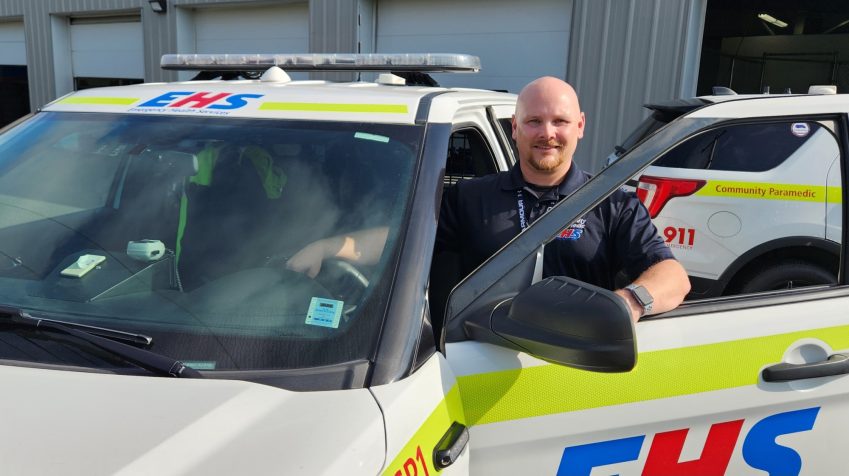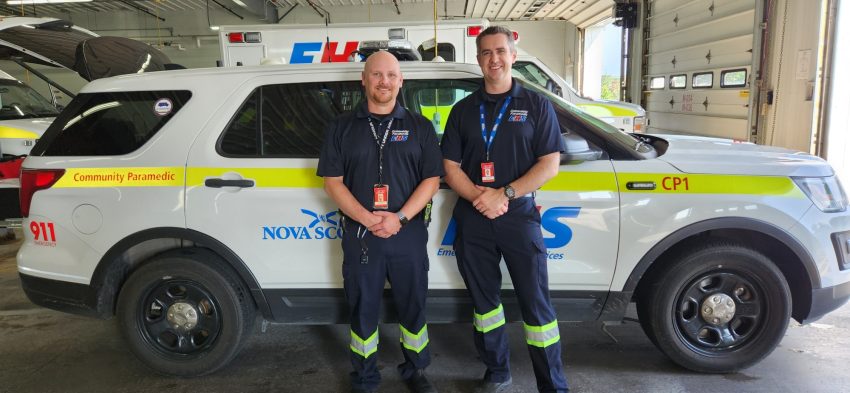- English
- français
Not all Lights and Sirens: Care and Connection
In Nova Scotia, there are over 1,100+ paramedics who dedicate their lives to public service. To help better understand what daily life is like on the front lines of health care, we went behind the scenes, capturing the experiences of these first responders in their own words and photos.
Colin's Story
As Colin Mackinnon wraps up treating a patient, he hears a familiar comment that he and his team receive regularly.
“Thank you for getting me back on my feet,” the patient says.
For the last three years, Mackinnon has been part of the Cape Breton Community-based Paramedic Program, which has changed how patients receive care in that area.
“It’s super rewarding,” Colin says. “People are always happy to see you. They can’t praise the program enough and they can’t wait to see you again.”

The Program
Since its launch in December 2018, the Cape Breton Community-based Paramedic Program has seen community paramedics perform in-home services and clinical support telecare nurses provide virtual care services to patients up to 72 hours after being discharged from the Cape Breton Regional Hospital and Glace Bay General Hospital in-patient units or Emergency Departments.
Subsequent phases of the program have included services on the surgical floors of the Cape Breton Regional Hospital (CBRH), with additional phases planned in the future.
The program operates via a referral-based system where patients are referred by a doctor, nurse practitioner, nurse or respiratory therapist. The overarching goal of the program is to support patients and ensure they can receive treatment at home, keeping them out of hospital.
“It truly is the future of paramedicine,” says Tyler MacCuspic, a veteran community paramedic.

To be a community paramedic, you need to wear many hats. Their days are full of information gathering, collaboration, assessments and education.
“We can be influencers,” Tyler says.
A Team of Caregivers
In collaboration with the care team, which also includes the nurse, doctor, and referrer, they investigate a patient’s situation and prepare an evaluation from top to bottom.
From medication, antibiotics, hydration, taking blood, and assessing wounds, community paramedics also provide education on falls prevention and can recommend community support through programs such as Victoria Order of Nurses, Red Cross, Meals on Wheels and more.
“Ultimately, we treat people appropriately in a place they are comfortable with,” Tyler says.
“The long-term outlook for individuals, people do better at home than in a facility,” he adds.
Colin has been a field paramedic for 20 years. He describes the switch as a change of pace, noting that it is much different than a day on “the trucks.”
“With this, you have to slow down the assessment a little bit. It’s more of a slow medicine type of thing and a lot of preemptive work,” he says.
His morning begins by reviewing the schedule, with a possible one to five patients he may visit per shift. He then starts to plan out his day.
It’s Personal
The phone rings in the morning, and Colin discusses appointments and patients’ needs with the nurse. He reads a chart that details their name, address, diagnosis, treatments, living situation, and what he is being asked to do when he visits the patient’s home.
“You’re a guest in someone else’s house,” Colin states.
“You want to know the whole picture. You want their whole history. We have to support them outside the hospital so they don’t go back.”
He checks the supplies and equipment in his vehicle before heading out, then maps out his route.
Arriving at his first appointment, the patient and family welcome him with open arms. “I love that you are here,” says the patient’s spouse. “I love this program.”
Colin asks the patient everything, from their eating and drinking habits, to their pain, sleep and bowel movements. He assesses their medications, medical history and past treatments, forming a picture of how they care for themselves, what possibly led to their hospitalization, and how he can treat them out of hospital.
He takes vitals before and after treatment. Most importantly, he makes sure the patient is comfortable.
Sometimes the patient lives alone but in this case, the patient was surrounded by a supportive and curious family. While waiting for IV fluids to finish, Colin has a deep discussion with the patient.
It’s not small talk — it’s personal.
A Plan to Thrive
These conversations often run the gamut from their family, hobbies, work, neighbours, dreams and goals. The care and connection between the patient and community paramedic is deeply personal because trust has been built in a short time.
Colin can see the program’s purpose from visiting one single patient.
“Ultimately, we want to give them that autonomy to stay at home and to treat themselves well at home, and get the support they need,” he says. “They thrive in their home.”
And the appreciation from patients and their families demonstrates that Colin, Tyler and the rest of the team are doing just that.
Filed under What We Do Employee Spotlight







